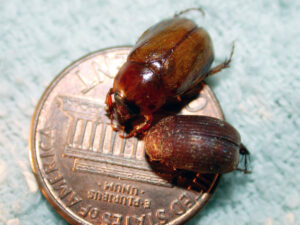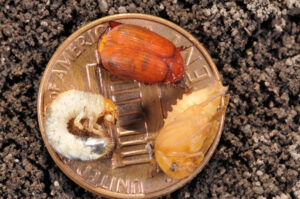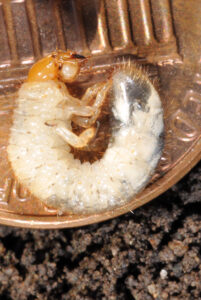Key Features
- Round, brown beetle
- Chewed leaves and flowers
- Chewed roots
Symptoms
Leaf margins are chewed by adult beetles. Leaves are stripped and left in a ragged appearance after adult feeding which is much different than the skeletonization caused by Japanese beetle feeding. Adults are about the size of Japanese beetles. Larvae are c-shaped grubs with a distinctive white pocket beneath their jaw.
- Asiatic garden beetle and masked chafer beetle. AGB is larger of the two
- Asiatic garden beetle; adult, pupa, grub
- White pouch under jaw of AGB grub
Biology
Adult beetles emerge from the soil mainly from mid-July to mid-August, but may be found anytime from late June through October. Adults are pests of many ornamentals especially asters, dahlias and chrysanthemum. They feed on foliage at night and return to the soil during the day. Unlike Japanese beetle, adults do not skeletonize leaves, but rather notch the foliage. Larvae feed on organic matter, roots and root hairs within the soil.
Management
When leaf shredding is detected, apply a broad spectrum insecticide, such as liquid carbaryl, to leaves when beetles are seen feeding on trees. Apply these products after mixing with water according to directions on the pesticide label. Most materials will only kill beetles for 4 to 5 days. Pyrethroids like bifenthrin provide longer control up to 10 days. To protect bees do not apply these products when plants are flowering. An alternative approach is to apply azadirachtin or neem oil to repel beetles. This works best before beetles have begun feeding in large numbers on plants. Manually destroy the occasional white grub encountered in the soil during flower planting to reduce damage by this and other grub species. If grubs are found in the pots of purchased plants, destroy the grubs by hand picking them from the pots and dropping into soapy water.
Effective Pesticides
Active Ingredients include: Azadirachtin, Bifenthrin, Carbaryl (Sevin), Cyfluthrin, Lambda- cyhalothrin, Permethrin, Pyrethrin, Resmethrin
Resources
- Not satisfied with ID? Contact the Purdue Plant and Pest Diagnostic Lab
- Sign Up for the Purdue Landscape Report
- Asiatic Garden Beetle Damage Reported in Northern Counties | Purdue University Pest&Crop newsletter
All photos by John Obermeyer. This story came from The Purdue Plant Doctor.


